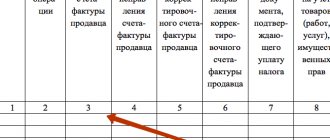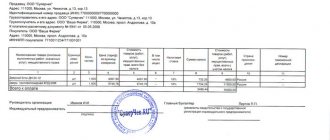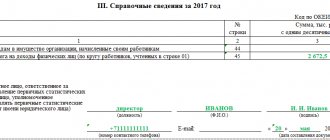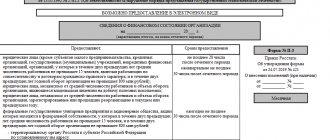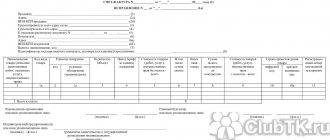The purchase ledger collects information about invoices received from sellers. Reflection of the received document in the book is carried out using registration records, which are sequentially entered into the tabular section as the document is received. Keeping a book is mandatory for persons recognized as VAT payers. Subsequently, information from this journal is used to generate the 8th section of quarterly tax reporting on added tax. In this article we will look at the purchase book form, provide a sample and instructions for filling it out.
Who is required to fill out
If an organization charges and pays VAT, then its direct responsibility is to maintain a book of purchases and sales.
The first, for example, is used to calculate tax deductions for VAT. In this case, it is necessary to carefully monitor the order of registration. During desk audits of tax authorities, these documents must be provided. In the article you will find a current example of a book of purchases and sales from January 1, 2021. Institutions have the right to refuse to maintain such a register, provided that they:
- exempt from performing the duties of a VAT payer (Articles 145, 145.1 of the Tax Code of the Russian Federation);
- sell goods, works or services only outside the territory of the Russian Federation;
- perform only those operations that are not subject to VAT in accordance with Art. 149 of the Tax Code of the Russian Federation.
Accounting documents do not have a unified form; they are maintained both in paper and electronic form and can be filled out in the format specified in the accounting policy of a budget organization (Article 10 402-FZ). Tax registers are formally strictly regulated by RF PP No. 1137 of December 26, 2011.
Errors in filling out the purchase book
The purchase book is an important document, since recently its contents have been used when filling out a VAT return. In this regard, special attention must be paid to the correct execution of the document. Errors in the registration records of the purchase book can lead to the Federal Tax Service refusing to reimburse the added tax accepted for deduction or, at least, to the requirement to provide additional explanations to the tax service, which is also very unpleasant.
An incorrectly completed ledger may also cause problems when preparing a declaration due to inconsistencies in the data format.
Reasons for the main errors:
- Accountant's carelessness;
- Ignorance of the rules for filling out the book;
- Insufficiently clearly defined rules regarding individual and non-standard transactions.
The first two reasons are easier to deal with; the accountant’s task is to carefully study the filling rules and check the recorded information several times. As for the third reason, in some cases it is advisable to seek clarification from the competent authority, for example, the Federal Tax Service.
Design rules
Documentation can be maintained both on paper and in electronic form - at the discretion of the taxpayer (clause 1 of the Rules for maintaining books of purchases and sales, approved by the RF Government of December 26, 2011 No. 1137). However, the required documents are sent to the territorial bodies of the Federal Tax Service only electronically, along with the VAT declaration (clause 5 of Article 174 of the Tax Code of the Russian Federation).
If the institution maintains paper document flow, then upon the end of the quarter, before the 25th day of the month following the reporting one, copies of tax registers must be signed, laced, each page numbered and secured with a “living” seal. The hard copy is signed by the head of the institution or a responsible person appointed directly by the head.
If the documentation is maintained in electronic format, the registration procedure is greatly simplified: a printed copy is not required to be provided, and when sent to the local tax authority through an electronic document management system, the generated package is signed using an enhanced qualified electronic signature key.
According to the provisions of the Order of the Federal Tax Service of Russia dated October 29, 2014 No. ММВ-7-3 / [email protected] , the data reflected in the registers is indicated directly not only in the accounting, but also in the tax reporting - in sections 8 (purchases) and 9 (sales) ) value added tax returns line by line.
Each entry for a given quarter corresponds to a separate section in the return.
Results
Always use a current purchase ledger form.
Now this is a form as amended by Decree of the Government of the Russian Federation dated August 19, 2017 No. 981, which made technical amendments to the names of individual columns, clarified the procedure for filling out the purchase book, and also prescribed a new procedure for making corrections to the purchase book. You can find more complete information on the topic in ConsultantPlus. Free trial access to the system for 2 days.
Innovations for 2021
As of 04/01/2018, the rules for compiling the purchase and sales book have been changed (Resolution No. 98 of 02/01/2018). Key innovations are related to the Tax-free system. Now companies have the right to include in the CP data on checks issued to foreigners in order to receive VAT compensation (clause 1 of Article 169.1 of the Tax Code).
Please note that this information about the check must be registered in the KP on the date the right to deduct the value added tax arises, in accordance with paragraph 11 of Article 172 of the Tax Code of the Russian Federation.
How to register data:
- in column 3 we indicate the number and date of the check issued under the Tax-free system;
- in column 7 we enter the serial number, as well as the date of the Tax-free fiscal receipt;
- Column 13 - indicate information about the stamp of the Customs Service representative made on the Tax-free check;
- in column 15 we write down the cost of goods from the fiscal receipt. We indicate the price including VAT;
- in column 16 we enter the VAT amount indicated in the Tax-free check, which is confirmed by the customs stamp.
Let us remind you that these rules are required to be applied only by those organizations that sold goods to foreigners using the Tax Free system. Other taxpayers form books of purchases and sales according to general rules.
What information is required?
According to paragraph 2, ordinary, adjustment and corrected invoices are entered in the book.
They can be on paper forms or in electronic form. Entries in them are usually made on a computer. Some information may be entered manually.
The purchase ledger contains the following invoices:
- issued by persons selling products or services (rule 2 of the Rules for maintaining a purchase ledger);
- compiled when providing goods, works, services (GWS) (clause 22 of the Rules of Practice);
- adjusted when the price initially specified by the seller decreases and the buyer increases it (clauses 9 and 12 of the Rules of Practice);
- necessary when carrying out construction and installation works for personal use (clause 20 of the Rules of Practice);
In addition, the sales book also includes documentation that can be considered sufficient grounds for deducting VAT:
- papers (it is acceptable to include copies of them) that contain information about expenses for work trips (clause 18 of the Rules of Practice);
- documents that confirm the fact of payment of tax when importing (clause 6 of the Rules);
- statements on the import of goods and payment of indirect taxes - when importing goods from countries included in the EAEU (clause 6 of the Rules of Practice).
Sales book
Organizations and individual entrepreneurs who are VAT payers are required to keep a sales book.
The form is approved in Appendix No. 5 of Resolution No. 1137. You can download the 2021 sales book form for free at the end of the article.
The following documents are subject to registration in the form:
- invoices and adjustment invoices;
- strict reporting forms;
- cash receipts;
- invoices;
- other documents influencing the tax increase.
Documents are registered in all cases when the obligation to calculate VAT arises. In this case, the filling rules technically coincide with those provided for the formation of a purchase book, with the only difference being that information is recorded from documents issued by the taxpayer himself.
What is reflected in the document?
The purchase book contains:
- The header contains information about the taxpayer-buyer, that is, its full or abbreviated name according to the statutory documents (or full name of the individual entrepreneur, INN and KPP). Data on tax cycles (with start and end dates).
- The tabular section contains information about the documents used to calculate VAT and its value.
If GWS are provided for actions subject to taxation at rates of 18, 10 and 0%, then the invoice is noted at the parts corresponding to these rates (clause 6 of the Rules for maintaining a purchase book, letter of the Ministry of Finance of Russia dated March 17, 2015 No. 03-07-11/14238 and 03/02/2015 No. 03-07-09/10695).
If the supply is intended for taxable and non-taxable actions, then the document is drawn up for the amount of the deduction after determining the size of the accounted share (clause 6 of the Rules of Practice).
Sample document
At the beginning of the book, on the title page, information about the individual entrepreneur is entered - this section should not cause any difficulties, since information from personal and constituent documents is included here:
- FULL NAME;
- TIN;
- residential address;
- information about the tax authority where the taxpayer was registered;
- data from the registration certificate, etc.
Information is also provided about the bank where the individual entrepreneur has an account and the cash register number if he uses it in his work. Then the entrepreneur puts his signature on the page and dates the form.
Filling out section 1 KUDiR
This includes raw materials, semi-finished products and other inventory items for the acquisition of which the individual entrepreneur spent his own funds. They must be taken into account even if the expenses were made in the previous reporting period, and the de facto receipt occurred in the current one.
Advances that are planned to be provided in the coming periods are also indicated here.
Expenses take into account actual expenses that have occurred for the purpose of subsequently obtaining financial benefits from business operations.
It should be noted that the amount of financial expenses when carrying out business activities is written off as expenses only if the produced inventory items are sold. If there are statutory expense norms for this part, then accounting is carried out based on them.
The first section contains several block tables. Blocks 1-1 to 1-7 must be filled out by individual entrepreneurs who are employed in the manufacturing sector. Moreover, each block has two options, the first of which (version A) is used by entrepreneurs working with VAT, and the second (version B) is used by those who do not allocate VAT in their operations.
If you go in order, then Table 1-1 contains data on raw materials purchased and consumed in the process of the individual entrepreneur’s work.
Cells of block 1-2 include semi-finished products (purchased and spent) for production needs.
Block lines numbered 1-3 are intended to account for auxiliary raw materials and materials (purchased and consumed).
Block 1-4 contains other material costs, i.e. energy, water, fuel, etc. which were spent in the course of the activities of the individual entrepreneur.
Block 1-5 indicates the price of finished products that the individual entrepreneur produced during the reporting period, and also provides the cost of work performed and services provided during this time.
Blocks 1-6 and 1-7 show the result of production and sale of manufactured products at the time of commission and based on the results of the monthly period.
Filling out section 2 KUDiR
The second section of KUDiR concerns depreciation of fixed assets, small business enterprises and intangible assets. Depreciation can only be calculated in relation to the property of the entrepreneur, which was purchased with cash and used to carry out his work. Intangible assets include all types of intellectual property (trademarks, electronic programs, databases, etc.) that the individual entrepreneur uses in his activities. The rules for calculating depreciation are given in tables 3-1, 3-2, 3, 4-1, 4-2.
Filling out section 5 KUDiR
The fifth section of the book provides calculations of wages and taxes. The table given here is, in fact, a payroll sheet and is formed for each month separately. It contains
- calculated income tax,
- various other deductions,
- date of issue of funds
- and the employee’s signature upon receipt.
The table includes all types of payments, including wages themselves, material incentive payments, the price of goods issued in kind, etc.
Filling out section 6 KUDiR
The sixth section of KUDiR allows you to determine the tax base. It is formed after a year (according to the calendar) and is the basis for filling out the 3-NDFL form.
Block 6-1 includes income from sales indicated in table 1-7 and others. Data from blocks 1-7, 2-1, 2-2, 3-1, 4-1, 4-2, 5-1, 6-2 are given as expenses.
Block 6-2 includes all expenses of an individual entrepreneur not shown in other blocks, including expenses for fire safety and security systems, travel expenses, fees for consulting, information and legal services. services, Internet, telephone, costs for household and repair needs, etc.
The last block KUDiR (6-3) includes expenses made in the current reporting period, but income for which will be taken into account in the upcoming period. These include seasonal expenses, rental payments, etc.
How to punish for violating the rules of conducting KUDiR
The management of KUDiR must be approached responsibly. For the absence of a book or false information about income and expenses, you can be fined.
If requested by the tax authorities, the KUDiR must be provided within 10 days. If you do not do this, you may be fined 200 rubles for each book not provided.
If tax officials, during an audit, find at least two cases of incorrect reflection of income and expenses in the KUDiR, they face a fine of 10,000 to 30,000 rubles. And if this led to an understatement of tax, the fine will be 20% of the unpaid amount, but not less than 40,000 rubles.
